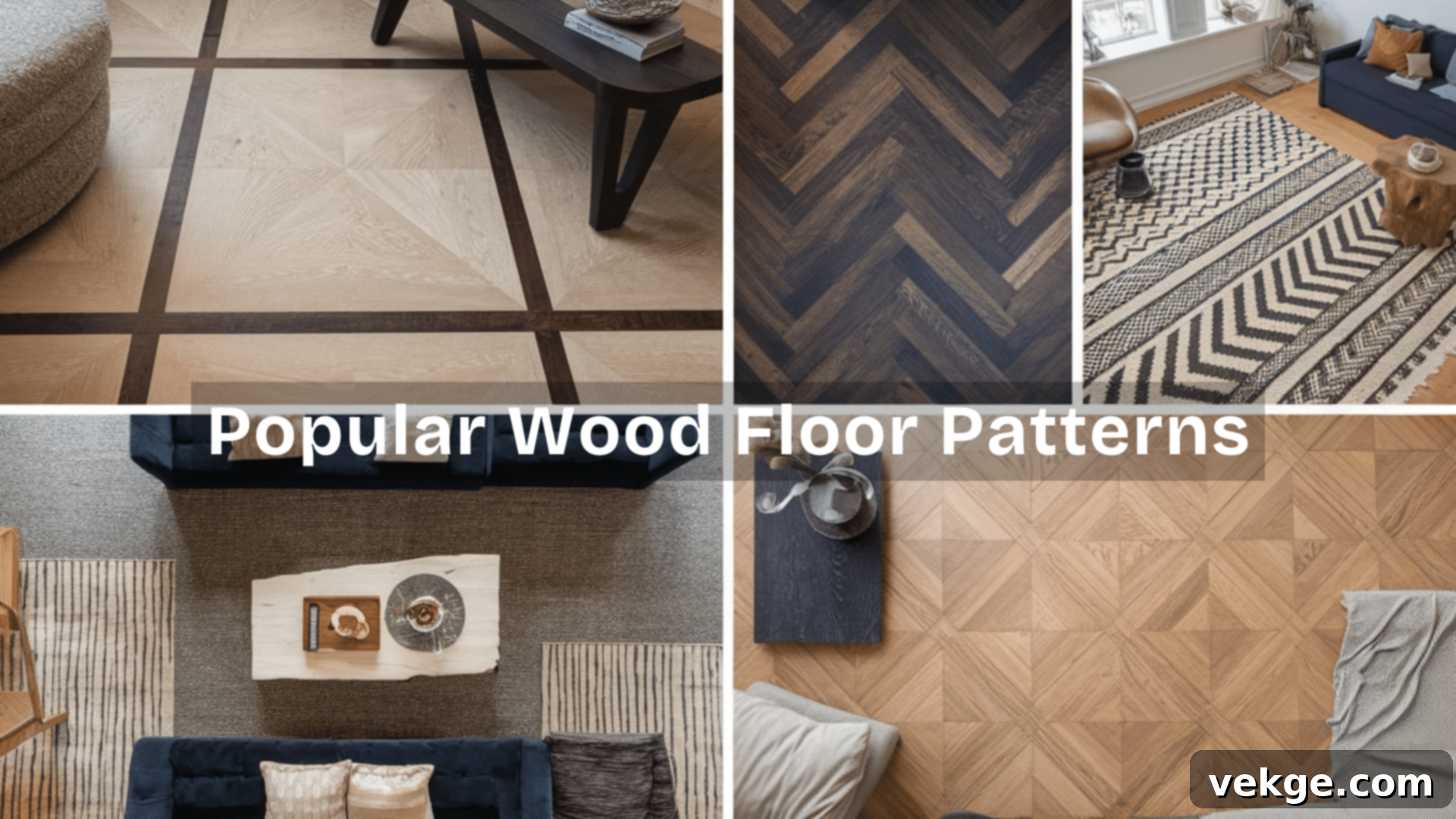Discover the Best Wood Floor Patterns: An Ultimate Guide to Designs & Styles for Your Home
Wood floor patterns offer a transformative power, capable of dramatically altering the aesthetic and atmosphere of any room. Whether your vision leans towards timeless tradition or striking contemporary uniqueness, selecting the perfect pattern is key to infusing your home with unparalleled character, warmth, and style. The right design choice can elevate a space from ordinary to extraordinary, reflecting your personal taste and enhancing the overall décor.
The world of wood flooring presents an endless array of possibilities, ranging from the understated elegance of simple straight lines to the intricate beauty of complex geometric arrangements. Each pattern tells a story and contributes a distinct visual appeal, making your floor a central design element rather than just a surface.
In this comprehensive guide, we will delve into a diverse selection of wood floor patterns. We’ll explore beloved traditional styles such as the classic herringbone and the sophisticated chevron, alongside more modern and trending designs like dynamic diagonal layouts and charming basket weave patterns. Our journey will cover the unique qualities of each, helping you envision how they might look in your own space.
Beyond simply showcasing patterns, we’ll provide practical advice on how to choose the best wood floor pattern that perfectly complements your home’s architecture, size, and existing décor. We’ll also share essential installation tips, discuss costs, and offer valuable maintenance strategies to ensure your beautiful wood floors remain stunning for decades to come. No matter your preference for wood type – be it the robust beauty of oak, the rich tones of walnut, or another exquisite timber – there is a floor pattern designed to make your space truly stand out and leave a lasting impression.
Why Wooden Flooring is a Great Investment for Your Home
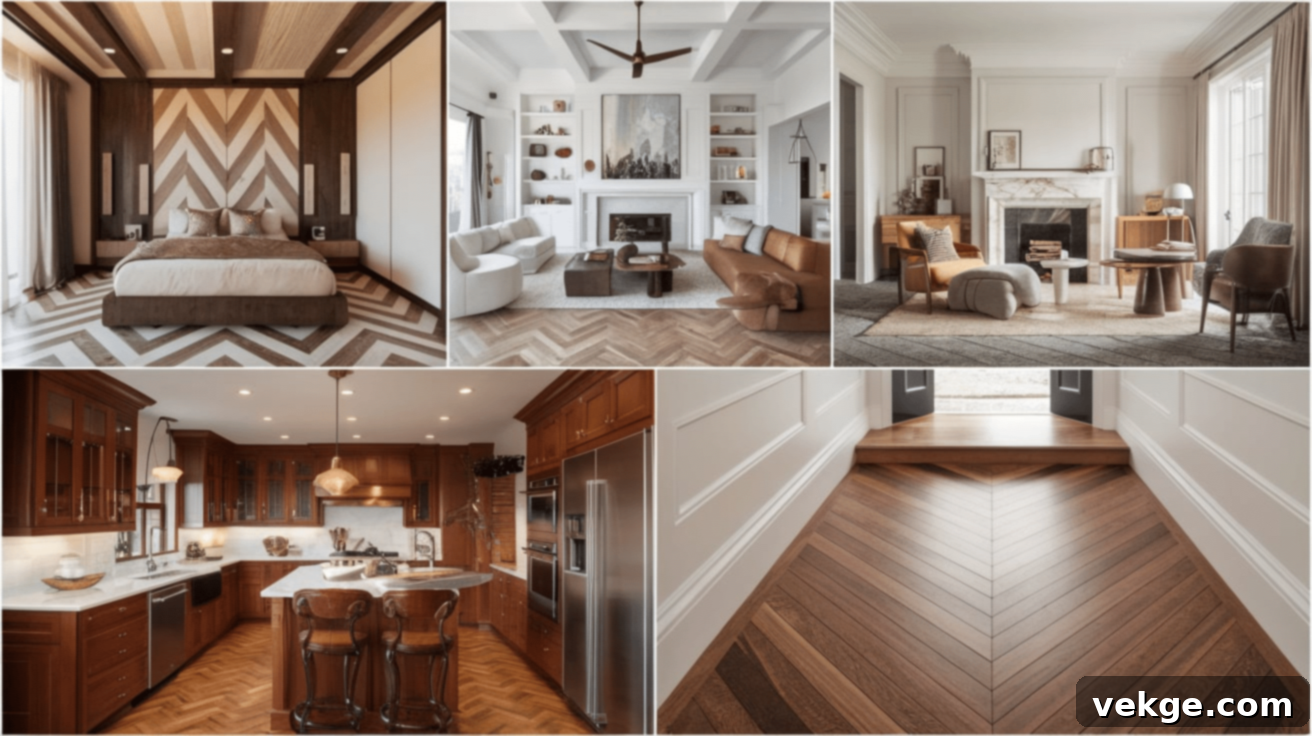
Wooden flooring remains a perennial favorite among homeowners, and for excellent reasons. Its inherent beauty is matched by a host of practical benefits, solidifying its status as an outstanding flooring option suitable for virtually any room in your residence.
1. Unmatched Durability: Wood floors are renowned for their exceptional strength and longevity. With proper care and maintenance, a quality wood floor can easily last for many decades, often outliving other flooring types. Unlike carpets that quickly show wear and tear, wood floors maintain their elegant appearance and even develop a richer patina with age, enhancing their character over time. This makes them a wise, long-term investment.
2. Effortless Maintenance and Hygiene: One of the most appealing aspects of wooden floors is their ease of cleaning. A quick sweep, vacuum, or damp mop is usually all it takes to remove dirt, dust, and debris. Crucially, wood floors do not trap allergens, dust mites, or pet dander like carpets do, making them a healthier choice for households, particularly those with allergy sufferers. Their non-porous surface also resists stains more effectively than many other materials.
3. Significant Increase in Home Value: Installing wooden floors is a proven way to boost your home’s market value. Their timeless, classic appeal is universally attractive to potential buyers, suggesting quality and sophistication. Real estate professionals often note that homes with hardwood floors command higher prices and sell more quickly, making them a desirable feature for any property.
4. Versatility to Match Any Style: Wood floors possess an incredible stylistic versatility. Whether your interior design aesthetic is rustic farmhouse, sleek modern, traditional colonial, or minimalist chic, there’s a wood style that seamlessly integrates. The vast selection of wood types, stains, finishes, and plank widths allows for endless customization, ensuring your floor perfectly complements your evolving décor preferences.
5. Environmentally Conscious Choice: When sourced responsibly, wooden floors represent an eco-friendly flooring option. Many types of wood are renewable resources, and selecting products certified by organizations like the Forest Stewardship Council (FSC) ensures that the timber was harvested sustainably. Opting for wood can be a greener choice compared to synthetic alternatives, contributing to a healthier planet.
In summary, wooden flooring is a superior choice due to its enduring durability, simple maintenance, significant contribution to home value, adaptability to various styles, and potential for environmental friendliness. Whether you are constructing a new home or undertaking a major renovation, investing in wood floors is a smart decision that pays dividends in beauty, function, and value.
Exploring Popular Wood Floor Patterns and Designs
Wood floors come in an astonishing variety of patterns, each capable of imparting its own distinct style and character to a room. Whether you’re seeking a subtle backdrop or a striking focal point, there is a wood floor pattern perfectly suited for every home and design vision. Below, we explore some of the most popular and impactful wood floor patterns:
1. Straight Lay Pattern
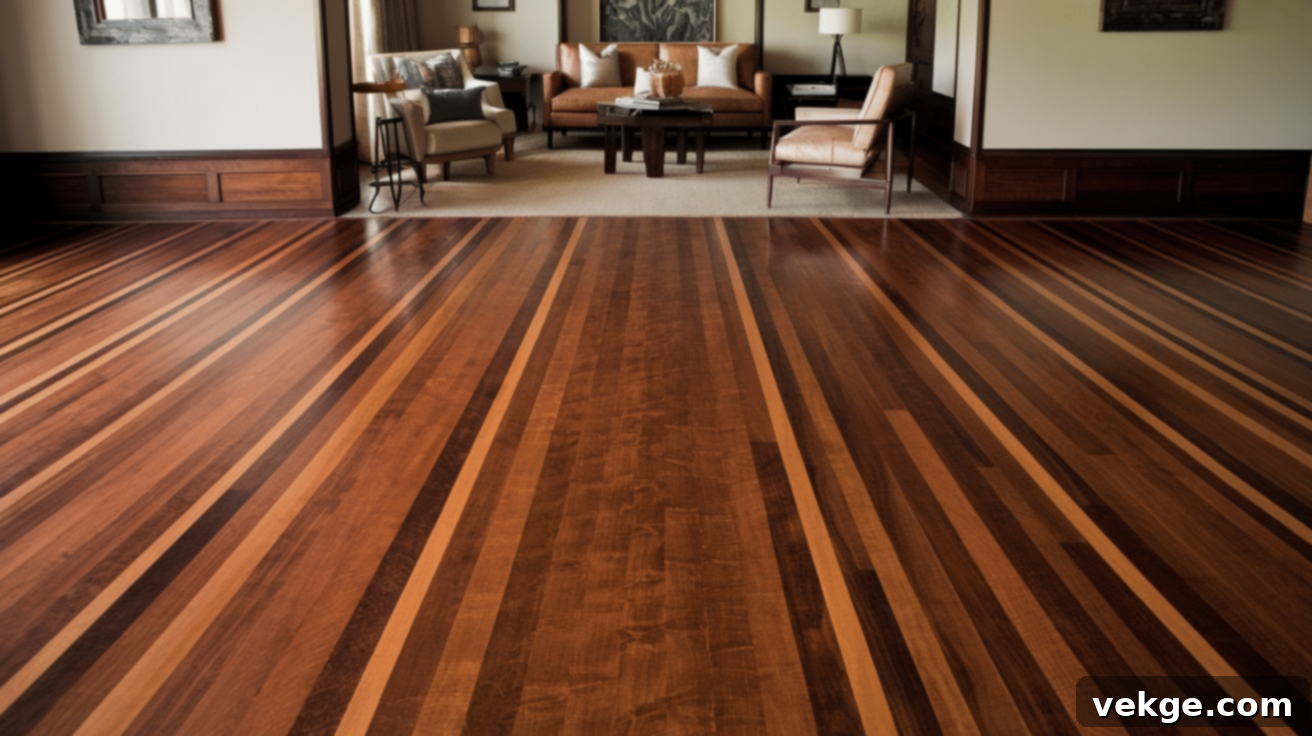
The straight lay pattern is arguably the most fundamental, widely recognized, and common style of wood flooring. In this design, individual wood planks are installed in straight, parallel lines running across the length or width of the room. This pattern exudes simplicity, cleanliness, and a timeless classic appeal, making it an exceptionally versatile choice that seamlessly integrates into almost any room in your home. It’s particularly effective in making smaller or irregularly shaped rooms feel more expansive and uncluttered, providing a calm and cohesive foundation for your interior design.
2. Herringbone Pattern
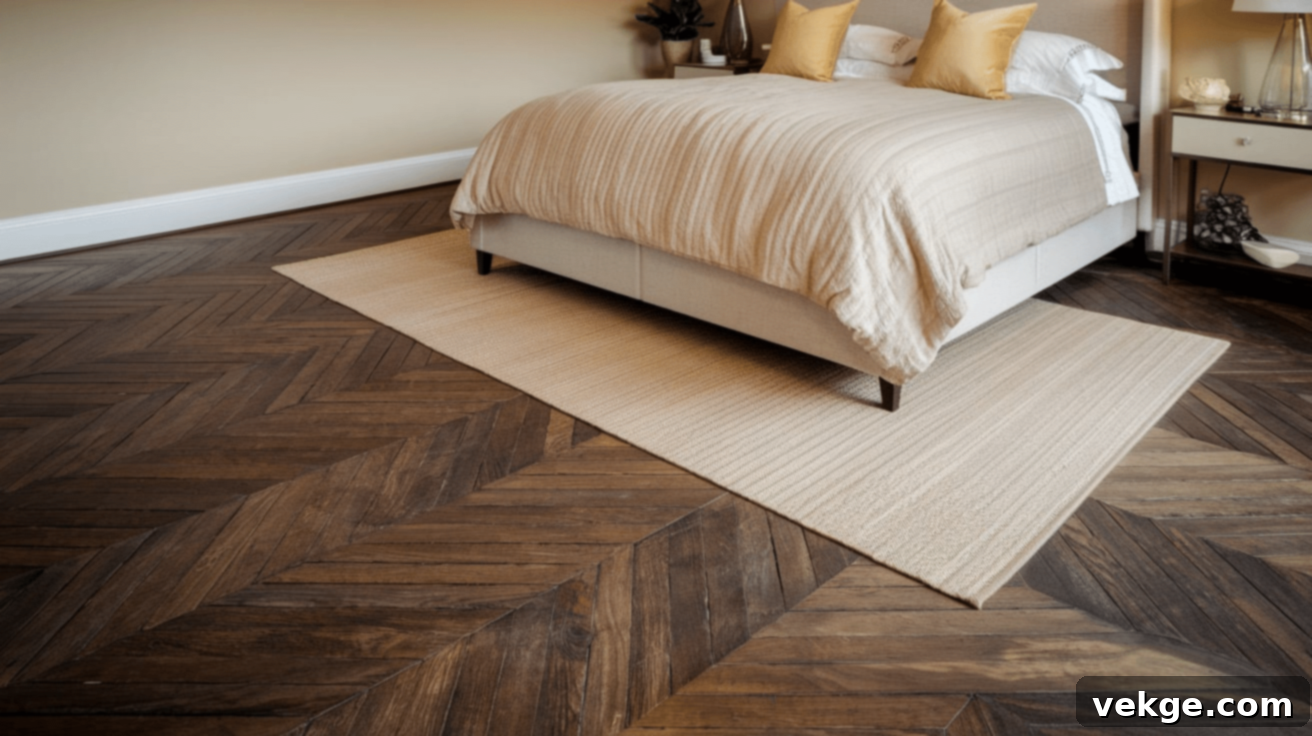
The herringbone pattern is a distinctive zigzag arrangement, characterized by rectangular planks cut at a 90-degree angle and laid in an offset manner to form a broken zigzag, resembling a series of “V” shapes. This pattern is more elaborate and visually impactful than the straight lay, making it an excellent choice for adding sophisticated texture and compelling visual interest to a space. Herringbone flooring has a rich historical pedigree, often seen in grand European estates, yet it adapts beautifully to both traditional and strikingly modern room designs, complementing a wide array of décor styles from elegant to industrial.
3. Chevron Pattern

Similar in concept to herringbone, the chevron pattern also creates a “V” shape, but with a crucial difference: the planks are cut at an angle (typically 45 or 60 degrees) and joined precisely at the point to form a continuous, sharp zigzag line. This creates a more uniform and structured “V” effect, lending itself to a distinctly modern and refined aesthetic that can make a powerful design statement in your space. Chevron patterns are particularly impactful in larger rooms such as spacious living areas, elegant dining rooms, or master bedrooms, where they can create a dramatic sense of movement and visual grandeur.
4. Diagonal Pattern
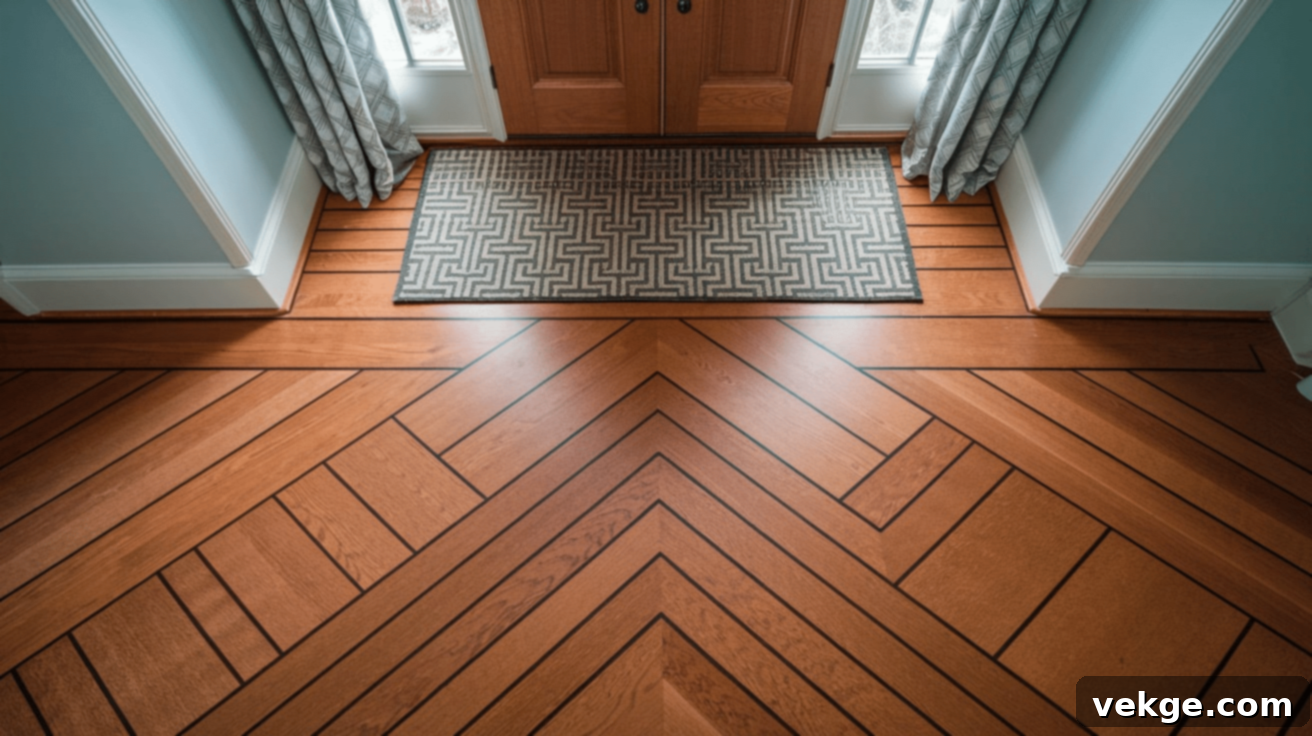
In a diagonal wood floor pattern, the planks are installed at a 45-degree angle to the room’s walls, rather than parallel or perpendicular. This unconventional orientation introduces a dynamic sense of movement and flow into the room, creating an optical illusion that often makes spaces feel significantly larger and more expansive than they truly are. It’s an exceptionally clever option for compact rooms, narrow hallways, or entryways, where it effectively draws the eye across the space, thereby helping them appear more open and less confined.
5. Basket Weave Pattern

The basket weave pattern employs square or rectangular wood tiles, or short planks, arranged in an interlocking crisscross formation, mimicking the intricate appearance of a woven basket. This distinctive pattern adds a layer of intricate sophistication and timeless charm, perfect for cultivating a classic, artisanal, or even Mediterranean-inspired look in your home. Its geometric repetition can be a captivating feature in various parts of the house, from studies to kitchens, and is particularly effective in adding visual depth and interest, making minimalist designs pop with a touch of detailed craftsmanship.
6. Parquet Pattern
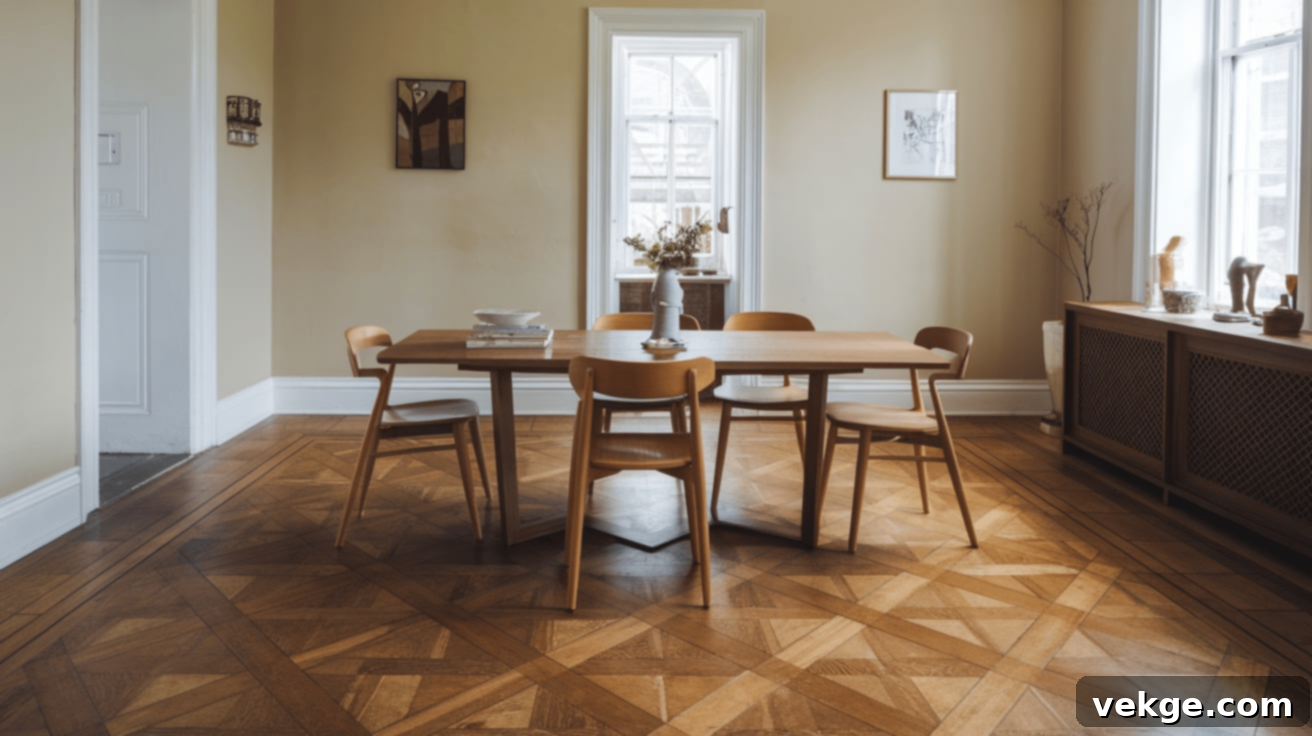
Parquet flooring refers to a broad category of patterns created from small, precisely cut individual pieces of wood arranged in complex geometric designs such as squares, triangles, or diamonds. This highly detailed and artful pattern is synonymous with luxury and bespoke craftsmanship. It excels in formal spaces like grand dining rooms, elegant libraries, or foyers where you desire to infuse an extra layer of style, historical grandeur, and artistic flair. Parquet pairs beautifully with both antique wooden furniture and sleek, plain contemporary pieces, allowing the intricate flooring itself to become the undeniable focal point of the room’s design.
7. Random Width Pattern
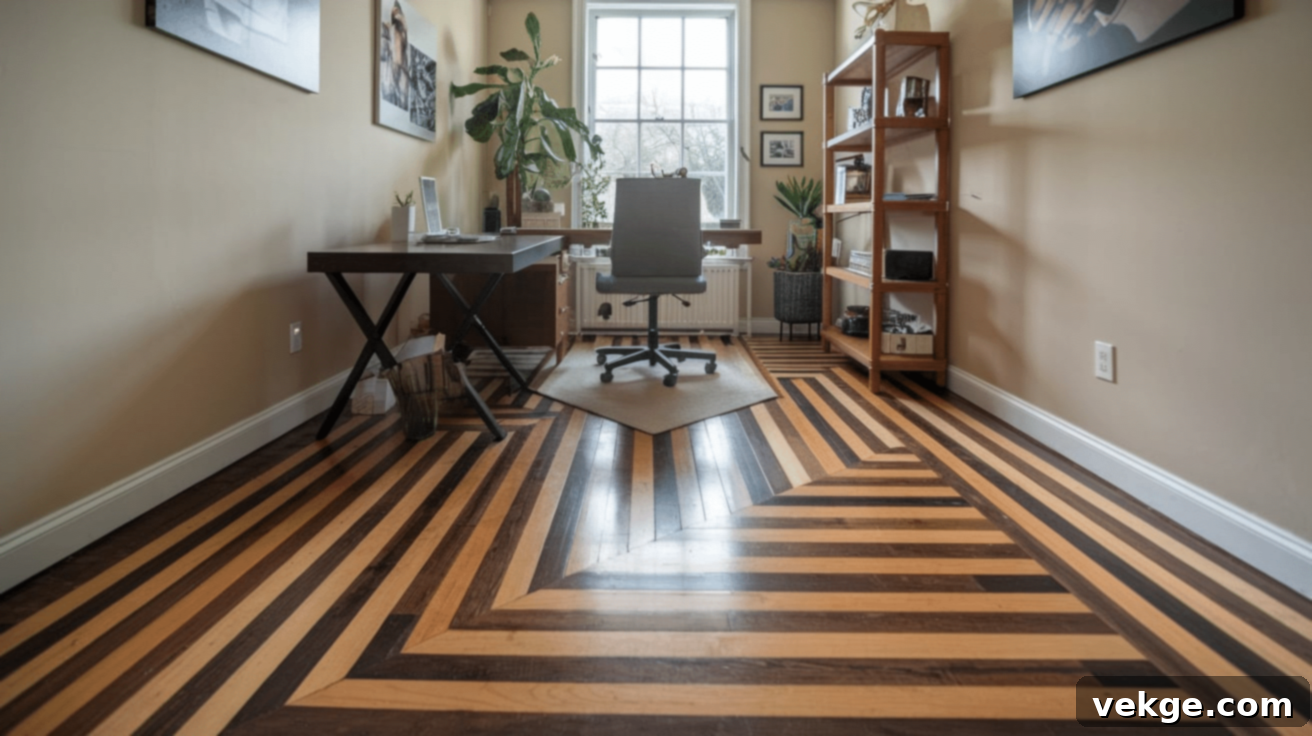
As its name suggests, the random width pattern utilizes wood planks of varying widths installed side-by-side, creating a uniquely organic, rustic, and natural aesthetic. The diversity in plank sizes gives the floor an authentic, time-worn feel, as if it were constructed from timber pieces of different ages or sourced from various trees. This pattern is particularly effective in spaces that aim to evoke a warm, cozy, and traditional ambiance, such as country-style kitchens, inviting home offices, or comfortable guest bedrooms. It adds depth and an appealing visual texture without being overly formal.
8. Brick Pattern (Staggered or Running Bond)
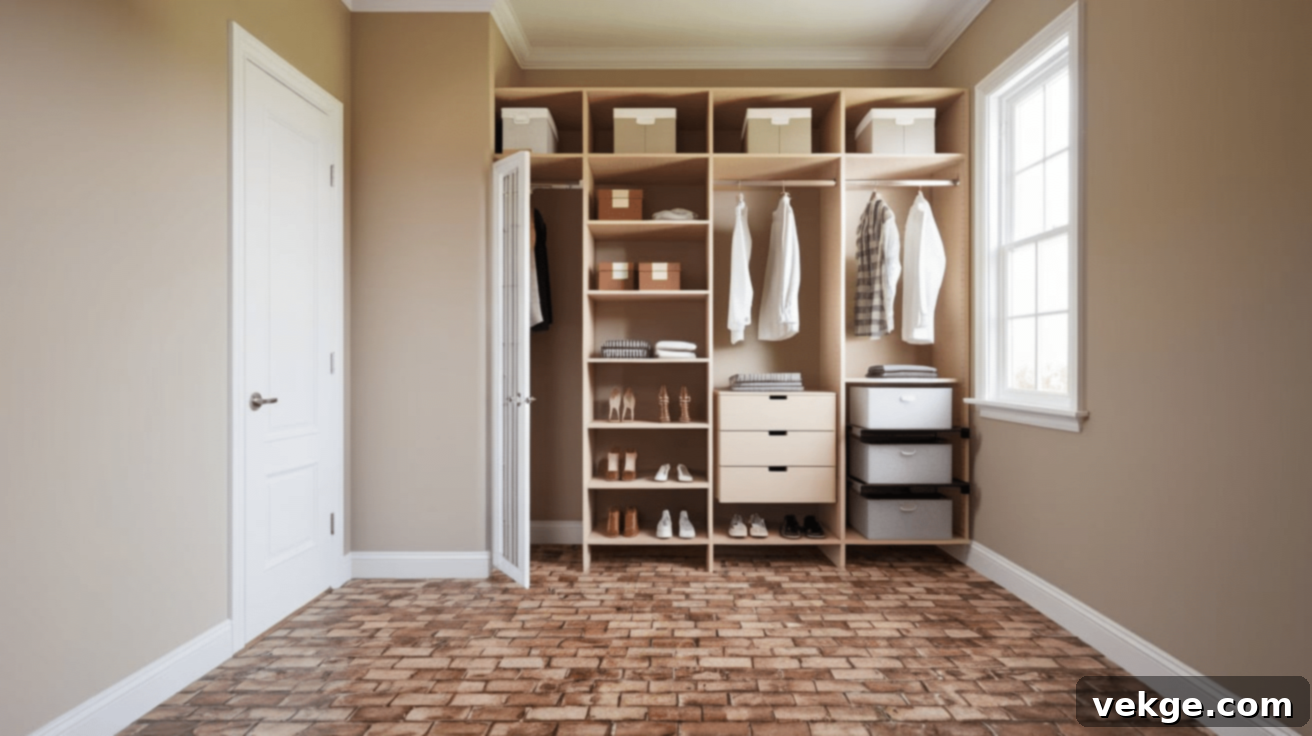
In the brick pattern, also known as a running bond, wood planks are laid out in consecutive rows, with each row offset by a consistent amount (typically half the length of a plank) from the one before it. This creates a classic, familiar, and highly stable design reminiscent of a traditional brick wall. This layout offers a timeless yet straightforward look that is incredibly versatile, fitting seamlessly into both modern, clean-lined spaces and more rustic or traditional interiors. The offset arrangement introduces subtle texture and depth to the floor, making it visually engaging without appearing overly busy or distracting.
9. Vertical Planks Pattern
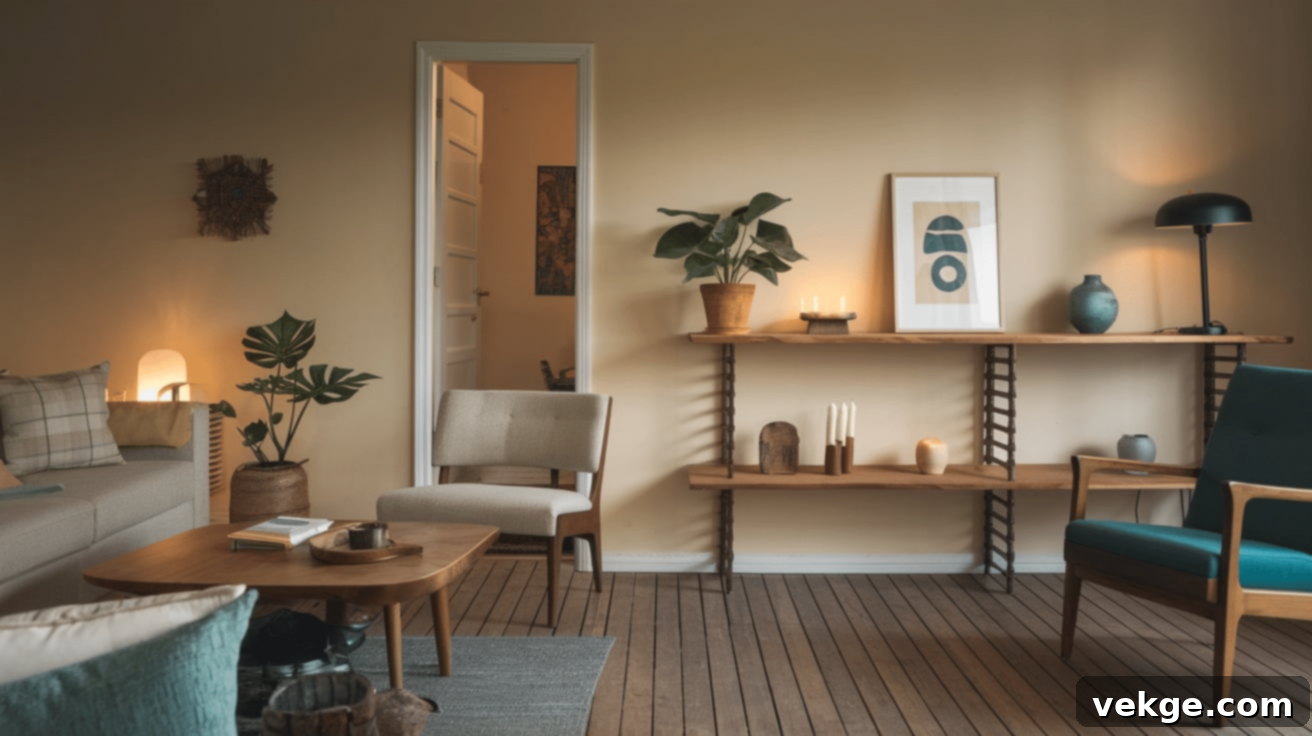
When installed as vertical planks, the wood runs from one end of the room to the other, parallel to the shortest walls, making the room appear longer. This pattern is particularly effective in smaller or more compact spaces, where the extended visual lines can draw the eye along the length of the room, creating an illusion of greater depth and expansiveness. This orientation can make a room feel more elongated and graceful, fostering an open and airy sensation, especially in narrow hallways or smaller bedrooms.
10. Horizontal Planks Pattern
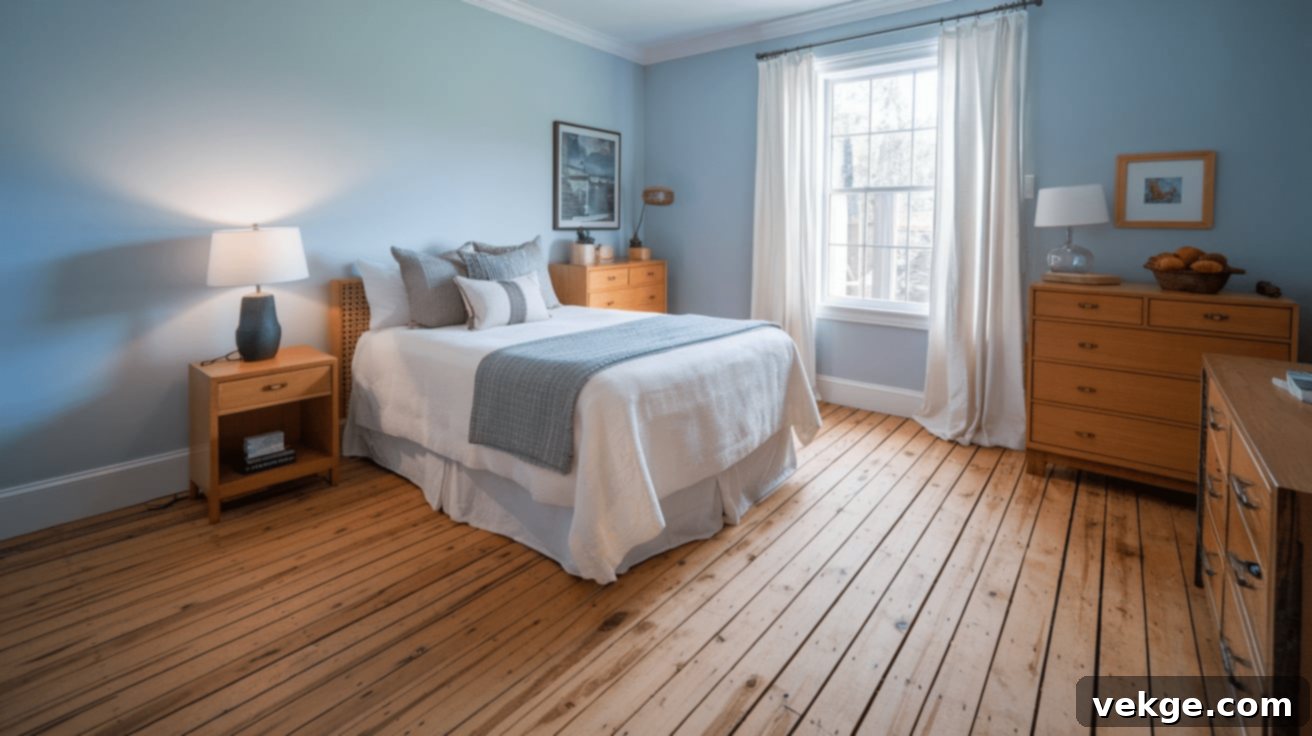
With horizontal planks, the wood is arranged across the room, parallel to the longest walls, extending from one side to the other. This layout is specifically designed to make a room feel wider, making it an ideal choice for inherently narrow spaces that could benefit from a visual expansion. The horizontal lines subtly broaden the room’s perceived width, contributing to a more open, balanced, and flowing feel. This simple yet effective design is remarkably adaptable and complements a wide range of interior styles, from contemporary minimalist to cozy farmhouse aesthetics.
11. Checkerboard Pattern
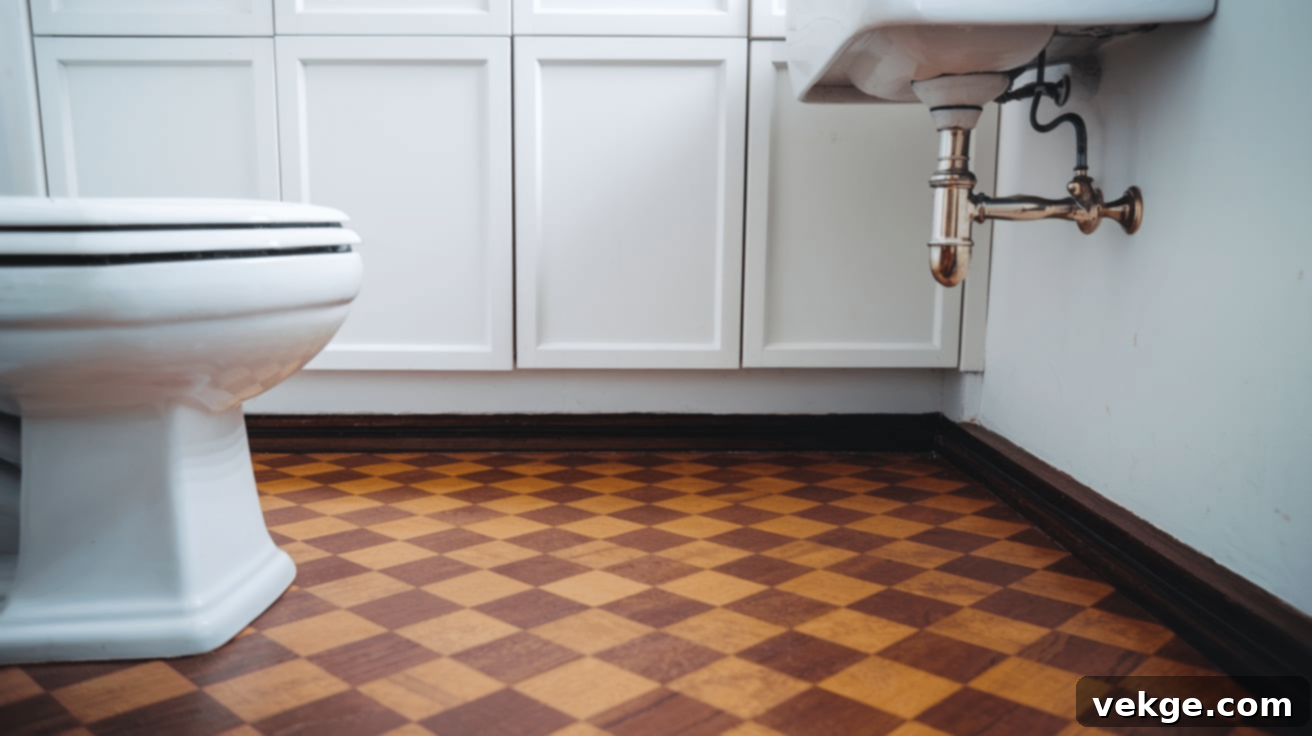
The checkerboard pattern achieves a bold and high-contrast look by alternating between light and dark wood planks, or sometimes different wood types, arranged in a grid-like formation. This striking pattern is perfect for spaces where you aim to create a playful, energetic, yet inherently sophisticated vibe. It can be a captivating design element in kitchens, entryways, or even eclectic living rooms, instantly grabbing attention and serving as a powerful visual anchor. The sharp contrast between the light and dark elements makes the floor truly pop, adding a unique dynamism to the room.
12. Fan Pattern
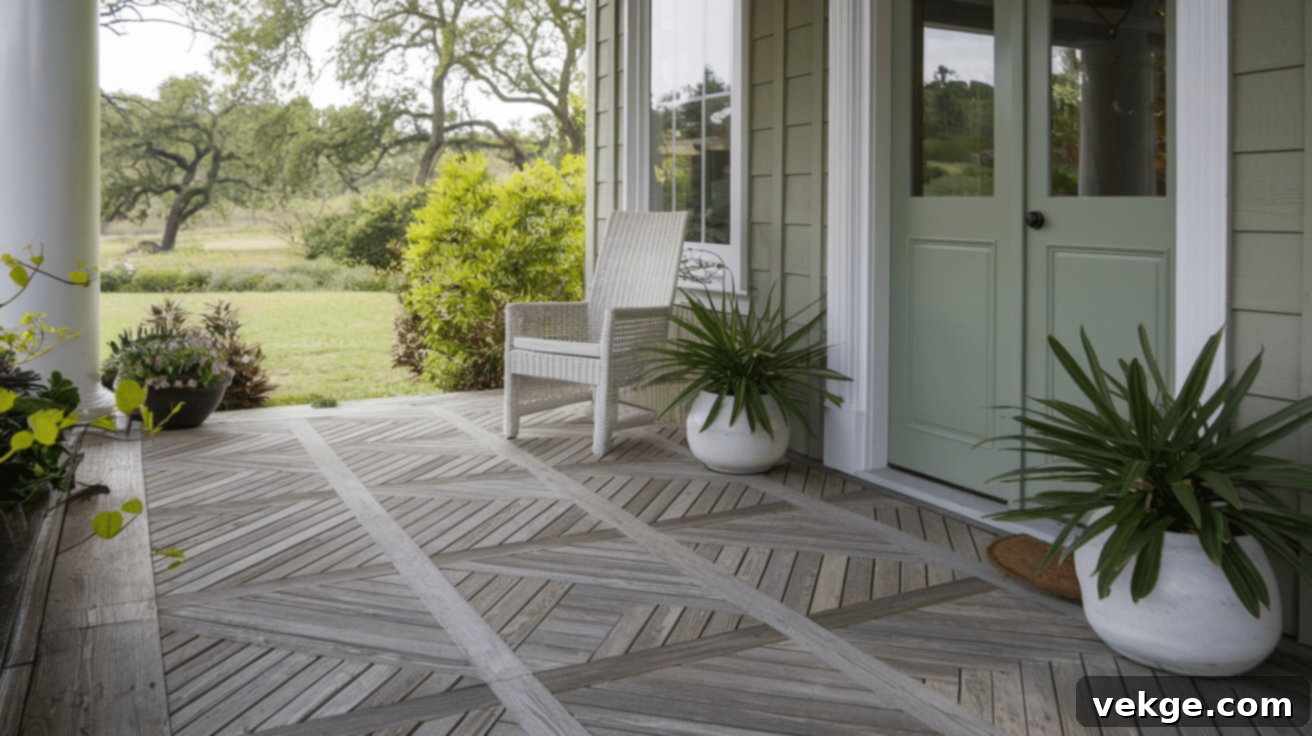
In the exquisite fan pattern, wood planks are meticulously arranged to radiate outwards from a central point, forming a beautiful, flowing fan-like shape. This highly unique and artistic design is often strategically placed in the center of a room or entryway, transforming the floor into an undeniable showpiece and focal point of the space. It delivers a stylish and dramatic look that can effortlessly evoke a vintage charm, an Art Deco elegance, or a bespoke artistic flair, making your floors a true work of art.
13. Radiant Pattern (Sunburst)

The radiant pattern, often referred to as a sunburst, involves arranging wood planks in a captivating circular or starburst design, typically originating from the very center of a room. This bold and dramatic pattern instantly commands attention, creating a striking visual effect that infuses the space with a palpable sense of energy, movement, and grandeur. It’s a truly unique method of elevating a room’s design, making it feel dynamic and exceptionally special. Radiant floors are perfectly suited for rooms that demand a powerful design statement, such as expansive master bedrooms, elegant dining rooms, or grand ballrooms.
These diverse wood floor patterns each offer unique ways to enhance the visual appeal and overall feel of your home. From the enduring elegance of classic designs like herringbone and parquet to the innovative and modern impact of patterns like the radiant sunburst, there is a wood floor layout to perfectly match every style, architectural context, and personal preference, making your flooring a foundational element of your home’s beauty.
Best Wood Types for Popular Patterns
When embarking on the journey of choosing a wood floor pattern, selecting the appropriate type of wood is just as crucial as the pattern itself. Different wood species possess distinct characteristics in terms of hardness, grain, and color, which can significantly influence how a particular pattern looks and performs. Here’s a closer look at some of the best wood types and their ideal pattern pairings:
1. Oak: Oak is consistently one of the most popular and versatile wood choices for flooring, primarily due to its exceptional durability and attractive grain patterns. Both red oak and white oak are incredibly robust, making them suitable for high-traffic areas. Its prominent, open grain makes it an excellent canvas for almost any pattern, but it particularly shines with classic designs like Straight Lay, Herringbone, and Chevron, where its natural texture adds depth and character to the geometric lines.
2. Maple: Maple is a lighter-toned wood known for its smooth, fine, and consistent grain, offering a clean and contemporary aesthetic. It’s a very dense and hard wood, providing excellent resistance to dents and scratches. Its subtle grain ensures that the focus remains on the pattern itself, making it ideal for designs like Straight Lay and Diagonal, where its uniform appearance doesn’t distract from the linearity or angled layout. Maple is also fantastic for minimalist and Scandinavian-inspired interiors.
3. Walnut: Walnut is prized for its rich, deep chocolate-brown tones and often beautiful, flowing grain patterns, sometimes with hints of purplish or reddish hues. It exudes warmth, luxury, and sophistication, making it a premium choice for high-end interiors. While slightly softer than oak, its striking color more than compensates. Walnut is particularly stunning when used in Chevron and Herringbone patterns, where its deep, luxurious color dramatically highlights the sharp angles and intricate shapes, creating a truly opulent visual effect.
4. Hickory: Hickory is one of the hardest and most durable domestic wood species, making it an excellent choice for homes with pets, children, or high foot traffic. It boasts a bold, distinctive natural grain pattern with significant color variation, giving it a strong character. This makes hickory perfect for rustic, country-style, or industrial homes. It works exceptionally well with patterns like Basket Weave and Parquet, where its distinct grain adds a rugged texture and compelling visual interest that enhances the complexity of the design.
5. Ash: Ash is a light-colored wood, often with creamy tones, characterized by a prominent, open grain similar to oak but typically straighter. It’s known for its elasticity and strength, offering good durability. Its smooth texture and airy feel make it a fantastic choice for a variety of patterns, particularly those that benefit from a light and open aesthetic, helping to make rooms feel brighter and more spacious. Ash can handle significant wear and tear, making it a practical yet stylish option.
6. Cherry: Cherry wood is cherished for its distinctive reddish-brown tone that deepens beautifully over time, developing a rich, lustrous patina. It has a finer, less pronounced grain than oak, giving it a smooth, elegant appearance. While softer than some other hardwoods, its luxurious color and natural aging process are highly desirable. Cherry looks particularly magnificent with more elaborate patterns like Herringbone and Chevron, where its warm, sophisticated color creates a beautiful contrast with the sharp geometric angles, adding a touch of timeless elegance.
Ultimately, choosing the right wood type for your floor pattern is a balance between the desired aesthetic and the practical demands of your space, including anticipated foot traffic and overall desired ambiance. Whether you envision a floor of light, airy tones, rich, dark hues, or something beautifully textured in between, there is a perfect wood type that will impeccably complement your chosen pattern and ensure your flooring stands out as a true design feature.
How to Choose the Right Wood Floor Pattern for Your Home
Selecting the ideal wood floor pattern is a pivotal decision that can profoundly influence the entire ambiance and visual appeal of a room. It’s crucial to choose a style that harmonizes not only with your personal aesthetic preferences but also with the practical aspects of your space and its intended function. Here are several key factors to carefully consider when choosing a wood floor pattern for your home:
1. Consider Room Size and Shape
The dimensions and layout of your room significantly impact how a specific floor pattern will be perceived. For smaller rooms, patterns like the Straight Lay, especially with wider planks, or the Diagonal pattern can be incredibly effective. These designs help to visually expand the space, making it feel more open, less cramped, and more inviting. Conversely, in expansive rooms, more intricate and bold patterns such as Herringbone, Chevron, or even Parquet work exceptionally well. These designs add a luxurious sense of scale, texture, and visual interest, preventing large areas from feeling overwhelming or monotonous.
2. Match the Pattern to Your Home’s Overall Style
Reflect on the predominant architectural style and interior design aesthetic of your home. If your space embodies a traditional, classic, or formal elegance, patterns like Herringbone, Basket Weave, or complex Parquet will lend an authentic and sophisticated touch, evoking a sense of heritage and grandeur. For homes with a more modern, minimalist, or contemporary style, simpler patterns such as the Straight Lay, Diagonal, or Horizontal Planks often create a clean, uncluttered, and sleek foundation that perfectly complements modern furnishings and décor. For rustic or farmhouse styles, Random Width planks can add an organic and authentic charm.
3. Play with Angles and Direction
Patterns that incorporate angles, such as the Diagonal or Chevron, are excellent for introducing a dynamic sense of movement and flow into a room. These patterns are particularly effective in larger, open-plan spaces, long hallways, or entryways where you want to guide the eye and create a seamless transition between areas. They add energy and a contemporary edge. If you prefer a more understated and straightforward look, the Straight Lay pattern, whether running vertically or horizontally, provides a clean and timeless foundation that remains stylish without demanding excessive attention.
4. Don’t Forget About Wood Color and Finish
The color of your chosen wood floor, along with its finish, plays a critical role in how the pattern is perceived and how it contributes to the room’s atmosphere. Lighter woods like natural oak or maple can impart a fresh, airy, and expansive feel, making rooms appear brighter and more open. In contrast, darker woods such as rich walnut or deep cherry tend to create a cozier, more intimate, and often more formal vibe. Additionally, the finish (matte, satin, or gloss) can alter the reflection of light, influencing the visual impact of the pattern. Always ensure the selected wood color and finish harmoniously complement your chosen pattern and the overall design scheme of your home. It’s highly recommended to obtain samples and observe them in your home’s natural lighting throughout the day.
Choosing the right wood floor pattern is a deeply personal decision that hinges on your individual style, the desired functionality, and the specific atmosphere you wish to cultivate in your space. By carefully considering factors such as room size, your home’s existing style, the visual impact of angles, and the interplay of wood color and finish, you can confidently select the perfect pattern that will transform your house into a truly remarkable home.
Cost and Installation of Wood Floor Patterns
When considering the addition of a beautiful wood floor pattern to your home, understanding the associated costs and installation complexities is paramount. The overall expense can vary significantly based on the type of wood selected, the intricacy of the chosen pattern, and whether you opt for a DIY installation or hire seasoned professionals. This section will break down these crucial considerations.
1. Cost of Wood Floors
The primary factor influencing the cost of wood flooring is the species of wood you select. Generally, common domestic hardwoods like oak and maple are more affordable, offering excellent value for their durability and aesthetic appeal. Exotic woods or less common domestic species such as walnut and cherry tend to be at a higher price point due to their rarity, unique aesthetics, and sometimes specialized sourcing. On average, the raw material cost for hardwood flooring can range anywhere from $3 to $12 per square foot, with premium or engineered options sometimes exceeding this. Crucially, the more intricate the pattern – such as highly detailed Chevron, Parquet, or Fan designs – the higher the material cost can become. This is due to the increased wastage from precise cuts and the potential for specialized milling of the individual wood pieces.
2. Professional Installation Services
Opting for professional installation is often recommended, especially for complex wood floor patterns. The cost for professional installation typically ranges between $2 and $8 per square foot, depending on your geographic location, the installer’s experience, and, most significantly, the complexity of the pattern. This price usually encompasses labor, basic adhesives, and the use of specialized tools required for precise cuts and intricate layouts like Herringbone, Chevron, or Basket Weave. While a professional installer represents a higher upfront cost than a DIY approach, their expertise ensures a flawless finish, proper adherence to manufacturer specifications, and often comes with a warranty, potentially saving you significant time, frustration, and costly mistakes in the long run.
3. DIY Installation Considerations
If you possess a good level of handiness, have experience with home improvement projects, and are looking to reduce costs, undertaking a DIY installation can be a viable option. DIY installation is considerably simpler and more achievable for basic patterns like a Straight Lay, which primarily involves laying planks in straight, parallel lines. For this, you’ll need to purchase or rent essential tools such as a miter saw or table saw for cutting, a nail gun or staple gun for fastening, and potentially a tapping block and pull bar. While DIY installation can potentially save you up to half the cost of professional labor, it’s vital to recognize that more complex patterns – such as Herringbone, Chevron, or Parquet – demand meticulous measuring, precise cutting, and a high degree of patience and skill. Errors in these patterns can be visually unforgiving and difficult to rectify.
4. Potential Extra Costs
Beyond the cost of the wood material and installation labor, several other expenses should be factored into your budget.
- Underlayment: A protective layer installed between the subfloor and the wood planks. This can provide moisture protection, sound dampening, and a smoother surface for installation, typically costing around $0.50 to $1.50 per square foot.
- Subfloor Preparation: Old flooring removal, subfloor leveling, or repairs can add significant costs, often discovered only after the old flooring is removed.
- Adhesives and Fasteners: High-quality wood glues or specific nails/staples are essential, especially for certain patterns or engineered wood.
- Trim and Baseboards: To provide a finished look around the edges of your new floor, you may need new baseboards or quarter-round molding, which contributes to the overall project price.
- Finishing Supplies: If installing unfinished wood, you’ll need sanding, staining, and sealing materials.
Ultimately, the total cost of installing wood floor patterns is a sum of the wood type, pattern complexity, installation method (professional vs. DIY), and additional materials. If operating within a strict budget, beginning with a simpler pattern like the Straight Lay or undertaking the installation yourself for basic designs can help manage expenses while still achieving a stunning new look for your home. Always obtain detailed quotes and plan for potential contingencies.
Styling and Maintenance Tips for Wood Floor Patterns
Wood floors are not merely functional surfaces; they are foundational elements that add profound beauty, character, and value to any space. Once you’ve meticulously chosen and installed the perfect wood floor pattern, the next steps involve styling it to enhance your room’s overall aesthetic and implementing diligent maintenance practices to preserve its splendor for many years to come. Here are essential tips for both styling and maintaining your wood floor patterns:
Styling Tips for Wood Floor Patterns
1. Complement with the Right Furniture
The furniture you select should harmonize with, not compete with, your distinctive floor pattern. For bold and intricate patterns like Chevron or Herringbone, it’s often best to opt for simpler, more neutral-toned furniture pieces. This allows the captivating floor pattern to remain the star of the show without visual clutter. Conversely, if you have a more subtle pattern, such as a classic Straight Lay, you have more freedom to introduce furniture with richer textures, bolder colors, or unique designs, as they will enhance rather than overwhelm the understated elegance of the floor. Thoughtful furniture placement can truly highlight and compliment your exquisite wood floors.
2. Use Area Rugs to Define Spaces and Add Texture
Area rugs are powerful tools for adding warmth, comfort, and distinct visual boundaries within a room, especially in open-plan layouts. They can effectively break up large expanses of flooring and delineate different functional zones, such as a living area from a dining space. If your floor features a highly detailed pattern like Parquet or Basket Weave, choose rugs with simple designs, solid colors, or minimal patterns to avoid creating visual chaos. For more understated floor patterns, rugs with intricate designs or bold colors can introduce an exciting layer of texture and visual interest without overwhelming the space.
3. Choose a Harmonious Color Scheme
Wood floors inherently bring a significant amount of natural warmth and organic texture to a room. To create a balanced and sophisticated interior, consider pairing this warmth with cool-toned colors for your walls, larger furniture pieces, and accessories. Shades of gray, soothing blues, crisp whites, or muted greens can provide a refreshing contrast, preventing the room from feeling too heavy or overly warm. If your preference leans towards a more rustic, earthy, or bohemian aesthetic, complementing the natural tones of wood with a palette of deep browns, forest greens, burnt oranges, and other organic hues can create a rich, inviting, and cohesive environment.
4. Emphasize the Pattern with Minimalist Decor
Allow the inherent beauty and unique design of your wood floor pattern to truly shine by adopting a more minimalist approach to surrounding decoration. If you’ve invested in a dramatic pattern like Herringbone, Chevron, or a Radiant design, keep wall colors neutral, subtle, or monochromatic. Avoid overcrowding the space with excessive decorative items, busy artwork, or overwhelming textiles. A less-is-more approach ensures that the floor maintains its intended impact as a central design feature, allowing its craftsmanship and visual complexity to be fully appreciated.
Maintenance Tips for Wood Floor Patterns
Preserving the beauty and integrity of your wood floor patterns requires consistent, mindful care. These maintenance tips will help ensure your floors look stunning for decades:
1. Regular Sweeping, Vacuuming, and Mopping: Wood floors are remarkably easy to maintain with a consistent cleaning routine. Regularly sweep or vacuum (using a hard floor attachment) to remove abrasive dirt, grit, and dust that can scratch the finish over time. For deeper cleaning, mop with a damp (never wet) cloth or a specialized wood floor cleaner. Always avoid excessive water, which can cause warping or damage to the wood.
2. Protect from Scratches and Dents: To safeguard your wood floors from unsightly scratches and dents, especially in high-traffic zones or under heavy furniture, take preventative measures. Affix felt pads or furniture glides to the legs of all chairs, tables, and other movable furniture. Consider using area rugs or runners in entryways, hallways, and living areas where wear is most likely to occur. For office chairs, use floor mats specifically designed for hard surfaces.
3. Keep the Floor Dry and Address Spills Immediately: Water is the nemesis of wood floors. It’s imperative to wipe up any spills, pet accidents, or moisture immediately using a dry cloth to prevent water spots, staining, or potential warping and cupping of the planks. In moisture-prone areas like kitchens, bathrooms, or utility rooms, consider using a water-resistant sealant or choosing engineered wood floors with enhanced moisture protection for added peace of mind.
4. Refinishing When Needed: While durable, wood floors will inevitably show signs of wear, dullness, or minor scratches over many years of use. One of the greatest advantages of hardwood is its ability to be refinished. When the wood starts to look tired, scratched, or simply lacks its original luster, the top layer can be sanded down, and a new stain and protective finish can be applied, effectively restoring its original beauty and extending its lifespan by many more years. The frequency depends on traffic and care, but typically every 7-15 years.
5. Seasonal Care and Humidity Control: Wood is a natural material that reacts to changes in humidity, causing it to expand during humid months and contract during dry seasons. Significant fluctuations can lead to gaps between planks or even cracking. To maintain the floor in optimal condition, use a humidifier during dry winter months to prevent excessive shrinking and cracking, and ensure good ventilation during humid periods. Keeping indoor humidity levels between 35% and 55% is ideal for most wood floors.
By diligently following these comprehensive styling and maintenance tips, you can ensure that your chosen wood floor pattern not only remains in pristine condition but also continues to be a stunning and admired feature of your home for generations.
Conclusion
Choosing the right wood floor pattern is an immensely powerful design decision that can fundamentally transform the entire feel and character of a room. Whether your aesthetic preference leans towards the understated simplicity of a Straight Lay, the classic grandeur of Herringbone, or the bold statement of a Chevron, wood floors consistently infuse your home with unparalleled warmth, timeless style, and a distinct personality. Beyond their undeniable visual appeal, they offer durability and longevity that few other flooring options can match.
With appropriate care and consistent maintenance, your beautifully patterned wood floors are not just a temporary feature but a lasting investment, designed to endure for decades. They will continue to add a special touch and significant value to your living space, growing gracefully with your home.
As you make your selection, always remember to carefully consider the practical aspects: the size and unique dimensions of your room, the overarching style and existing décor of your home, and how the chosen pattern will seamlessly integrate with your daily lifestyle. Crucially, do not underestimate the importance of regular cleaning, prompt spill management, and diligent protection of your floors from potential damage. These simple yet effective practices are key to preserving their pristine condition.
Ultimately, no matter which captivating pattern you choose from the vast array available, wood floors stand as a classic, durable, and infinitely stylish choice that has the power to make any room feel uniquely special, welcoming, and profoundly elegant. They are truly the foundation of a beautiful home.
Frequently Asked Questions About Wood Floor Patterns
Here are some of the most common questions homeowners ask about wood floor patterns:
What is the easiest wood floor pattern to install?
The Straight Lay pattern is widely considered the easiest and most straightforward to install. The wood planks are simply laid in straight, parallel lines, making it a less complex and quicker process, especially for DIY enthusiasts or those new to flooring installation.
Can I install wood floor patterns myself?
Yes, you can certainly install simpler wood floor patterns like Straight Lay or a basic Diagonal layout yourself, provided you are comfortable using fundamental tools and possess some general home improvement experience. However, more intricate patterns such as Herringbone, Chevron, or Parquet demand advanced cutting skills, meticulous measurements, and a higher level of precision, which can be challenging for beginners.
Are wood floor patterns durable?
Absolutely, wood floor patterns are exceptionally durable when properly maintained and installed correctly. With a routine of regular cleaning, protection from excessive moisture, and prompt care, hardwoods like oak, maple, hickory, and ash can withstand heavy foot traffic and last for many years, often extending well beyond several decades.
Can wood floors be refinished if the pattern gets damaged?
Yes, one of the significant advantages of solid wood floors, regardless of the pattern, is their ability to be refinished. When the surface shows signs of significant wear, deep scratches, or dullness, the top layer of wood can be sanded down, and a fresh stain and new protective finish can be applied, effectively restoring the floor to its original beauty and vibrancy.
How do I choose the right wood floor pattern for a high-traffic area?
For high-traffic areas in your home, it’s advisable to prioritize both durability in the wood species and practical maintenance in the pattern. Opt for robust wood types known for their hardness, such as oak or hickory. Patterns like the classic Straight Lay or Diagonal are often preferred because they are easier to maintain, less prone to showing subtle wear and tear, and offer a stable foundation that holds up well under constant use.
